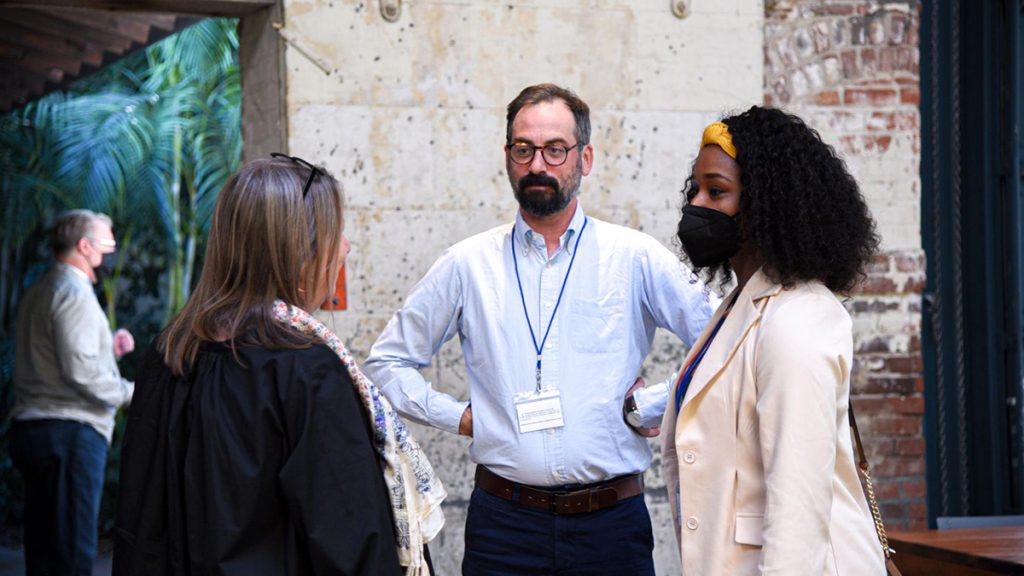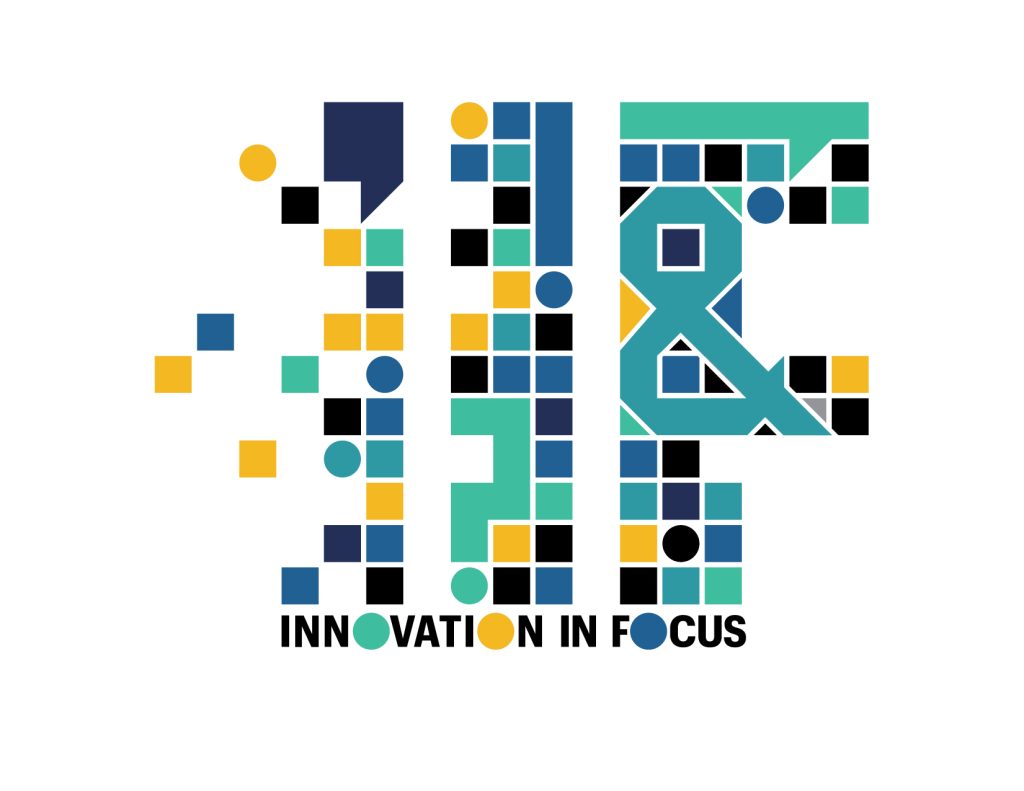
Sam Cholke, INN’s manager of distribution and audience growth, talks with members at the Online News Association conference. Photo: Fabiola Lopez
How to authentically ask for audience participation in newsletters
A conversation with Sam Cholke and Andrew Haeg
Sam Cholke is the manager of distribution and audience growth at the Institute for Nonprofit News, which promotes and supports more than 425 nonprofit journalism organizations. Cholke helps INN members better understand their audiences so journalists can connect with their communities more effectively. Andrew Haeg is the network product manager for INN, where he leads the development of new products with and for INN’s news organizations, helping the nonprofit news sector increase its impact and utilize new revenue streams.
We spoke with Cholke and Haeg to better understand how newsrooms can connect with audiences and drive engagement through newsletters.


Ward: How have you seen engagement work well in newsletters?
Cholke: We see a lot of people trying this kind of [strategy] because you need other signals of what’s working or not working in a newsletter besides an open rate. So you see a lot more people trying methods that require some action on the person. People are really responsive to direct email in a way that they’re not to you just putting something on your site. For people running engagement projects where they want to understand what their existing audience thinks or feels, or if they want ideas from the existing audience, there’s a lot of stuff happening on the newsletter list.
Ward: What do you think experimentation looks like in newsletters? Or, what have you seen in terms of audience participation?
Haeg: Whether it’s the decline of social and you’re not getting the same level of engagement there, or coming changes to SEO, I think there’s more and more emphasis on that direct relationship. But how do you manage that at any kind of scale without it blowing up your inbox every time? The other thing about surveys, having done maybe thousands of them, is that you have the burden of then doing something with all the responses, just as you’re finding out. So you can’t just say, “Hey, let’s do a survey, for, like our gift guide,” and then, “okay, we got a lot of responses and now we gotta do something really cool with them, otherwise it’s gonna be a waste.” I’ve kind of been obsessed with this over the years: developing systems that allow you to do that kind of call and response and then organize it. I do think AirTable allows you to do a lot of that in a way that’s pretty scalable, although expensive as you scale it, because you can create these embeddable galleries. They’re not beautiful, but I think if you did some design you could make those even better.
Ward: Do you have an example?
Haeg: I co-founded a site called Southwest Voices, now called Minneapolis Voices, which is a newsletter-based daily news product. We tried a lot of different things out, one of which was this. You gather perspectives and then go ahead and publish those and create that loop of engagement. You’re not only signaling to people that you’re listening, but you’re also creating content out of it. Another thing I’ve seen that I like a lot is this concept of a living FAQ. So, you’re asking your readers for questions about a topic and then you’re answering them, maybe not in the form of a 500 or 800-word story, but maybe just answering the question in a paragraph or a sentence, and then compiling an FAQ on that subject. I think that’s an incredible public service. And it’s a great form of content that can be evergreen.
Ward: Do you think there’s a sweet spot for soliciting engagement and sending surveys, or is there a risk of asking too much of your audience?
Haeg: If you’re doing a survey every three months, it starts to reach that point. Once a year, if you’re doing a big reader survey, makes sense. I think the only problem with that, then, is that it becomes kind of like a lagging indicator of how things are going because by the time you’ve done all the analysis, it’s pretty old information. So trying to do that in a lightweight way that’s more continuous, to me, that’s the sweet spot. What that looks like is really quite dependent on the newsroom and that relationship that you have with your readers. But I think that’s the ultimate goal, right? Developing a relationship and trying to become indispensable to that community and then adjusting your content based on what people are actually interested in.
Ward: What are some examples of strategies you’ve seen for building that relationship?
Cholke: One is when you develop an engagement strategy over email that’s intentionally about forwarding it to somebody else. Like, “send this email to somebody who can help us answer this question.” Because it’s meant to bring the people into the loop who care about a thing but may not have a relationship with the news organization. You’re utilizing the people on your list to try and connect with those [new] people and hopefully start a relationship. That makes that person feel useful, makes that person feel like they’re contributing and their voice is being raised up in a new way. It also helps you build out your list of people who are probably pretty sympathetic to your organization.
An example: Food Bank News does an annual Food Bank President of the Year campaign. So they reach out to their list and say, “Hey, we’re looking for nominations. Send us your nominations and also forward this to people who you think would want to nominate someone from their organization.” Those people are the ones you want reading. And those are people you want email addresses from. And so it does a couple of things: it helps us come up with story ideas and helps us feed things like a year-end feature or a live event that we could seek sponsorship on.
Ward: How do you make sure your asks of your audience are authentic and not extractive?
Haeg: I think an extractive form of sourcing is like, “Hey, we’re looking for someone who’s had this experience for a story that we’re doing.” Meanwhile, the rest of the people reading that are like, “Well, it’s a low probability that they’re ever gonna get around to me if they keep on asking for this kind of thing.” It just feels like you’re asking for what you need, instead of tapping into that sense of, “what’s the untold story? What’s the unheard voice? What are the perspectives that are being ignored?” I think those are very powerful and authentic reasons that people want to speak up.
Cholke: I’ll say, I did an engagement thing over email with essential workers during the pandemic. I had to email like 250 people and say, “Hey, I personally read your [story]. I really appreciate you sending this to me. I think X,Y or Z is an important thing that you’re connected with, and I’m pushing the reporters that we work with to look at your story and your concerns and think about reporting on it, too. We did this already that I wanted you to see, and we’re thinking about doing more. I just wanted to say thanks.” There were some things I could automate with AirTable, but I ended up writing a lot of personal responses.
Ward: What do you see for the future of newsletter engagement?
Haeg: From the standpoint of generating personalized newsletters with AI – that’s going to go so far off the rails so quickly. But I think it’s interesting. For summarization and assembling content that’s personalized to people, I think there’s a lot of promise there. It doesn’t have to feel robotic or impersonal; it can actually feel like as a reader, you’re getting a lot of stuff that’s relevant to you.
Cholke: I’m interested in AI in the data analysis space of getting all this data back from newsletters like how they’re being opened, how they’re being used, what clicks are happening, etc. It is really complicated to match up all these datasets that I have to export out of Mailchimp and match up with all my donor lists and all this other stuff. Maybe AI will take some of the burden off an audience person also needing to be a data analyst.
Editor’s Note: This interview has been edited for clarity and brevity.

Sign up for the Innovation in Focus Newsletter to get our articles, tips, guides and more in your inbox each month!


Comments